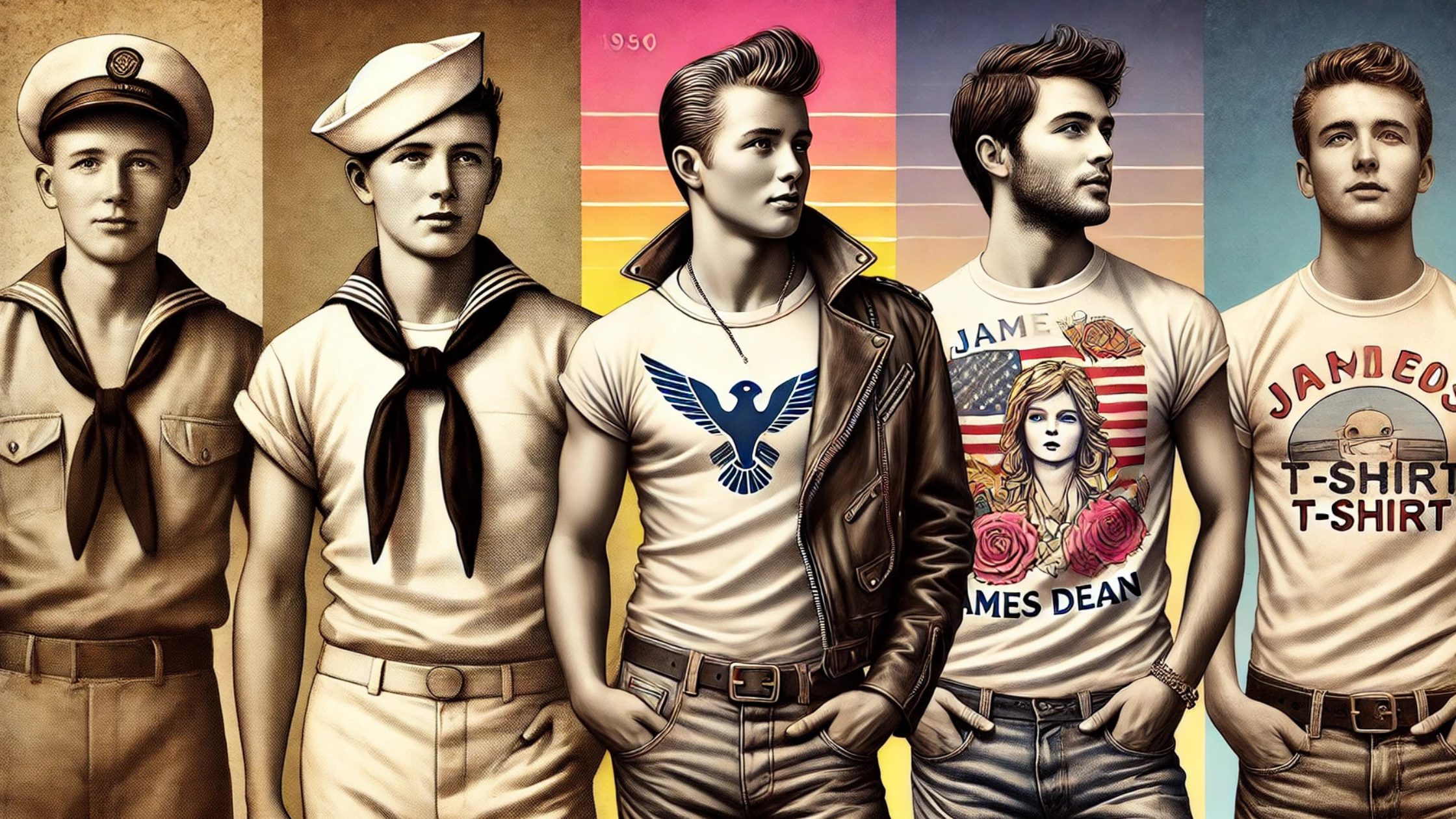
The Timeless Appeal of T-Shirts: A Journey Through Their Rise to Popularity
Introduction
T-shirts have become a global wardrobe staple, worn by everyone from children to grandparents, laborers to executives. They’re versatile, comfortable, and expressive—a garment that transcends class, culture, and geography. But when did the humble T-shirt transition from being an undergarment to an everyday essential? Why has this simple piece of clothing become one of the most popular garments in the world? This blog post explores the fascinating history, cultural influences, and societal trends that propelled T-shirts to their iconic status.
Origins: From Functionality to Fashion
The Birth of the T-Shirt (Late 19th to Early 20th Century)
The T-shirt’s story begins in the late 1800s as an evolution of the union suit, a one-piece undergarment popular in the 19th century. Workers in hot climates began cutting the union suit in half to create a more breathable alternative, and this innovation soon evolved into the crew-neck, short-sleeved shirt we recognize today.
By 1913, the U.S. Navy officially adopted the T-shirt as part of its uniform. These shirts were intended to be worn under uniforms and provided a lightweight, comfortable option for sailors working in warm conditions.
Post-War Popularity (1920s–1940s)
T-shirts gained a foothold outside the military thanks to servicemen who continued wearing them after returning home. In 1920, F. Scott Fitzgerald used the term “T-shirt” in his novel This Side of Paradise, marking its introduction into mainstream vocabulary. By the 1930s, companies like Hanes began mass-producing T-shirts for the public, promoting them as undergarments for men.
However, it wasn’t until World War II that T-shirts became widely recognized. Soldiers wore them as standalone garments in tropical climates, showcasing their practicality and comfort. When the war ended, T-shirts were no longer confined to the battlefield or factory—they began appearing in casual settings across the United States.
The T-Shirt Revolution: Hollywood and Youth Culture (1950s–1960s)
Hollywood’s Role in Popularizing T-Shirts
The 1950s marked a turning point in T-shirt history. Hollywood transformed the T-shirt from a functional garment into a symbol of rebellion and individuality. Marlon Brando’s portrayal of Stanley Kowalski in A Streetcar Named Desire (1951) featured him in a tight-fitting white T-shirt, exuding a raw masculinity that captured audiences’ attention.
Shortly after, James Dean cemented the T-shirt’s rebellious reputation in Rebel Without a Cause (1955). His character’s iconic look—a white T-shirt paired with a leather jacket—became a uniform for disaffected youth, signaling a break from traditional norms.
The Rise of Screen Printing
In the late 1950s, advancements in screen-printing technology allowed for the mass production of graphic T-shirts. This innovation opened the door for self-expression through clothing. Businesses, organizations, and individuals could now use T-shirts as wearable canvases for slogans, logos, and artwork.
The Counterculture Movement
By the 1960s, T-shirts became a vehicle for social and political messaging. The counterculture movement embraced the T-shirt as a way to communicate anti-war sentiments, civil rights activism, and environmental awareness. Iconic designs like the tie-dye T-shirt emerged during this era, symbolizing peace and individuality.
Mainstream Adoption and Commercialization (1970s–1980s)
Pop Culture and Band Merch
In the 1970s, the music industry played a pivotal role in popularizing T-shirts. Bands like The Rolling Stones and Pink Floyd began selling graphic tees featuring their logos and album art. Wearing a band T-shirt became a way for fans to show their allegiance and express their identity.
At the same time, T-shirts became a staple in the burgeoning sports merchandise market. Fans could support their favorite teams by donning logo-adorned shirts, further embedding the garment into popular culture.
Corporate Branding
During the 1980s, companies recognized the marketing potential of T-shirts. Brands like Coca-Cola and Nike began using T-shirts as promotional tools, emblazoning them with logos and catchy slogans. This trend marked the beginning of T-shirts as a powerful medium for advertising and consumer engagement.
The Influence of Subcultures
Subcultures also embraced T-shirts during this period. Punk rockers, skaters, and hip-hop artists adopted graphic tees to reflect their style and values. These groups helped cement the T-shirt’s reputation as a symbol of authenticity and individuality.
The Modern Era: T-Shirts in the 1990s and Beyond
Casualization of Fashion
The 1990s saw the rise of casual wear as a dominant fashion trend. Businesses began relaxing dress codes, allowing employees to wear T-shirts to the office on “casual Fridays.” This shift further normalized T-shirts as acceptable attire in a wide range of settings.
Technology and Customization
The advent of digital printing in the early 2000s revolutionized the T-shirt industry. Consumers could now create custom designs online, enabling greater personalization and creativity. This innovation also led to the proliferation of niche T-shirt businesses catering to specific interests and communities.
Social Media and Viral Trends
In the 2010s, social media platforms like Instagram and Pinterest amplified the popularity of T-shirts. Viral slogans, memes, and designs spread rapidly, making it easy for brands and creators to reach global audiences.
Platforms like Etsy and Redbubble further democratized the T-shirt market, allowing independent artists to sell their designs to a worldwide customer base.
Why Are T-Shirts So Popular?
1. Comfort and Versatility
T-shirts are made from soft, breathable fabrics like cotton, making them comfortable for everyday wear. Their simple design allows them to be dressed up or down, pairing equally well with jeans, skirts, or blazers.
2. Affordability
Compared to other types of clothing, T-shirts are relatively inexpensive to produce and purchase. This affordability has made them accessible to people across socioeconomic backgrounds.
3. Self-Expression
T-shirts serve as a blank canvas for self-expression. From political slogans to pop culture references, they allow wearers to communicate their interests, beliefs, and identities.
4. Universality
T-shirts are one of the few garments that transcend age, gender, and cultural boundaries. They are worn by people of all demographics, making them a truly universal piece of clothing.
5. Durability
T-shirts are durable and easy to maintain. They can withstand repeated washing and wear, making them a practical choice for everyday use.
The Future of T-Shirts: Sustainability and Innovation
As we move into the future, the T-shirt industry is embracing sustainability. Eco-friendly materials like organic cotton and recycled fabrics are becoming more popular, addressing concerns about the environmental impact of fast fashion.
Innovations in printing technology, such as 3D printing and augmented reality designs, are also pushing the boundaries of what T-shirts can be. These advancements ensure that T-shirts will continue to evolve while remaining a staple of modern fashion.
Conclusion
The T-shirt’s journey from an undergarment to a global icon is a testament to its adaptability and appeal. Over the decades, T-shirts have been shaped by cultural movements, technological advancements, and shifting societal norms. Today, they are more than just a piece of clothing—they are a medium for self-expression, a tool for communication, and a reflection of the times.
As trends come and go, one thing is certain: the T-shirt will remain a timeless and indispensable part of our wardrobes, continuing to adapt and thrive in an ever-changing world.



